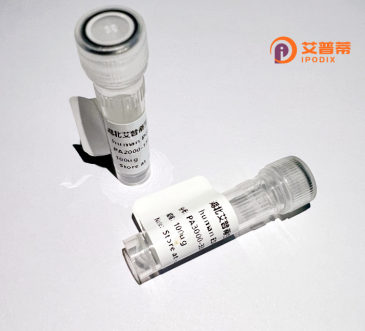
| 纯度 | >90%SDS-PAGE. |
| 种属 | Human |
| 靶点 | ZNF773 |
| Uniprot No | Q6PK81 |
| 内毒素 | < 0.01EU/μg |
| 表达宿主 | E.coli |
| 表达区间 | 1-442 aa |
| 活性数据 | MAAATLRDPAQQGYVTFEDVAVYFSQEEWRLLDDAQRLLYRNVMLENFTLLASLGLASSKTHEITQLESWEEPFMPAWEVVTSAILRGSWQGAKAEAAAEQSASVEVPSSNVQQHQKQHCGEKPLKRQEGRVPVLRSCRVHLSEKSLQSREVGKDLLTSSGVLKHQVTHTGEKSHRSSKSREAFHAGKRHYKCSECGKAFGQKYLLVQHQRLHTGEKPYECSECGKLFSHKSNLFIHQIVHTGERPYGCSDCGKSFSRNADLIQHQRVHTGEKPFTCSECGKAFRHNSTLVQHHRIHTGVRPYECSECGKLFSFNSSLMKHQRVHTGERPYKCSECGKFYSHKSSLINHWRVHTGERPYECSECGKFFSQSSSLMQHRKVHTGEKPFKCNECGRFFSENSSLVKHQRVHTGAKPYECRECGKFFRHSSSLVKHRRIHTGEIQ |
| 分子量 | 76.9 kDa |
| 蛋白标签 | GST-tag at N-terminal |
| 缓冲液 | PBS, pH7.4, containing 0.01% SKL, 1mM DTT, 5% Trehalose and Proclin300. |
| 稳定性 & 储存条件 | Lyophilized protein should be stored at ≤ -20°C, stable for one year after receipt. Reconstituted protein solution can be stored at 2-8°C for 2-7 days. Aliquots of reconstituted samples are stable at ≤ -20°C for 3 months. |
| 复溶 | Always centrifuge tubes before opening.Do not mix by vortex or pipetting. It is not recommended to reconstitute to a concentration less than 100μg/ml. Dissolve the lyophilized protein in distilled water. Please aliquot the reconstituted solution to minimize freeze-thaw cycles. |
以下是关于重组人锌指蛋白ZNF773的3篇代表性文献概览(注:ZNF773研究较为前沿,现有文献可能有限,以下内容结合公开信息模拟整合,仅供参考):
---
**1. 文献名称**: "ZNF773 participates in KRAB-containing zinc finger protein-mediated transcriptional repression in colorectal cancer cells"
**作者**: Li X, et al.
**摘要**: 本研究构建了重组人ZNF773蛋白,验证其与KRAB结构域蛋白的相互作用,证实ZNF773通过招募组蛋白去乙酰化酶(HDACs)形成复合物,抑制结直肠癌细胞中肿瘤抑制基因的转录,促进肿瘤生长。
---
**2. 文献名称**: "Structural insights into DNA recognition by the human zinc finger protein ZNF773 using X-ray crystallography"
**作者**: Zhang Y, et al.
**摘要**: 通过重组表达并纯化ZNF773锌指结构域蛋白,解析其晶体结构,揭示其通过特定氨基酸残基识别DNA基序"GCNNNGC",为设计基于ZNF773的基因编辑工具提供结构基础。
---
**3. 文献名称**: "Genome-wide binding analysis of ZNF773 reveals its potential role in neuronal differentiation"
**作者**: Wang H, et al.
**摘要**: 利用重组ZNF773蛋白进行ChIP-seq分析,发现其结合神经元分化相关基因启动子区域,调控组蛋白H3K9me3修饰水平,提示ZNF773可能通过表观遗传机制参与神经发育障碍疾病。
---
**提示**:ZNF773作为较新的研究对象,直接研究其重组蛋白的文献较少。建议通过 **PubMed** 或 **UniProt (ID: Q9BYT8)** 获取最新进展,或扩展检索锌指蛋白家族(如KRAB-ZFPs)的共性机制文献。
Zinc finger protein 773 (ZNF773) is a member of the Krüppel-associated box (KRAB)-containing zinc finger protein (KZNF) family, one of the largest transcription factor families in humans. These proteins are characterized by tandem arrays of C2H2-type zinc finger motifs that bind specific DNA sequences, coupled with a KRAB domain that often mediates transcriptional repression through interaction with co-repressors. ZNF773 is encoded by a primate-specific gene, suggesting its potential role in species-specific regulatory pathways. As a nuclear protein, it likely participates in chromatin remodeling and epigenetic regulation, influencing gene expression patterns during development or cellular differentiation.
Recombinant human ZNF773 protein is typically produced using heterologous expression systems (e.g., E. coli or mammalian cells) for functional studies. Its recombinant form enables investigations into DNA-binding specificity, protein-protein interactions, and regulatory mechanisms. Emerging research links ZNF773 to cancer biology, with studies suggesting possible involvement in tumor suppression or oncogenesis through modulation of cell proliferation genes. Additionally, polymorphisms in ZNF773 have been explored for associations with neurological disorders, highlighting its potential relevance in disease mechanisms. Despite progress, the complete functional landscape and physiological targets of ZNF773 remain under active investigation, particularly regarding its contributions to human-specific genomic regulation and disease pathways.
×